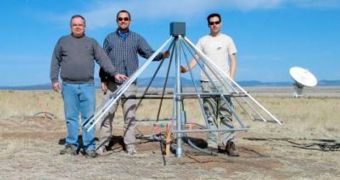The first two prototype antennas, out of a total of 13,000 to be constructed at the new Long Wavelength Array (LWA) observatory, have recently made their first measurements, as scientists in charge of the project have begun to calibrate and test them. They are, at this point, part of the Long Wavelength Demonstrator Array (LWDA), a smaller segment of the LWA, which is just meant to showcase the technology and prove its worth, ScienceDaily reports.
The new investigation was performed by experts at the Naval Research Laboratory (NRL) Space Science and Remote Sensing Divisions, working together with colleagues from the University of New Mexico (UNM) and the National Radio Astronomy Observatory (NRAO), in Socorro, New Mexico. The 300-year-old Cassiopeia A (Cas A) supernova remnant (SNR) was used as a target for the new observations, because it emits one of the strongest radio signals in the sky, which makes it relatively easy even for non-calibrated telescopes to find it.
The leader of the experiment team was Dr. Jake Hartman, an NRL scientist and a National Research Council (NRC) postdoctoral fellow. He used the LWDA to extend and verify a previous study, which was initiated by Dr. Joseph Helmboldt, an NRL-NRC postdoctoral fellow. Helmboldt showed in previous works that he conducted that the signal from Cas A was becoming increasingly smoother, and that it was essentially fading away, while showing a shorter term variability at frequencies under 100 MHz.
“Cas A has long been known to be fading, but the slower, seemingly irregular decrease at frequencies lower than 100 MHz has remained controversial. Dr Hartman's discovery reaffirms this supposition and provides strong support that more frequent time sampling will be needed to determine whether the shorter term variations contain a non-random component,” NRL LWA project scientist Dr. Namir Kassim, who is also an astronomer, explains.
“The result is exciting because it represents 'first science,' and is increasingly intriguing as it is based on measurements from only two dipole antennas, as compared to the more than 13,000 that will eventually comprise the full LWA. For a project whose broader goals encompass engaging and training a next generation of young radio scientists we are proud that this first astronomical result emerged from the work of two postdocs, neither of whom were experts in this area of research,” NRL astronomer Dr. Paul Ray concludes.

 14 DAY TRIAL //
14 DAY TRIAL //